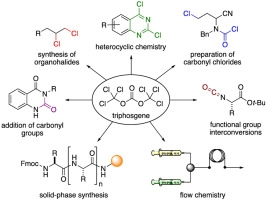A decade review of triphosgene and its applications in organic reactions

This review article highlights selected advances in triphosgene-enabled organic synthetic reactions that were reported in the decade of 2010–2019. Triphosgene is a versatile reagent in organic synthesis. It serves as a convenient substitute for the toxic phosgene gas. Despite its first known preparation in the late 19th century, the upward surge in the development of organic reactions using triphosgene interestingly began only three decades ago. Despite the relatively short history, triphosgene has been proven to be very useful in facilitating the preparation of a vast scope of value-added compounds, such as organohalides, acid chlorides, isocyanates, carbonyl addition adducts, heterocycles, among others. Furthermore, applications of triphosgene in complex molecules synthesis, polymer synthesis, and other techniques, such as flow chemistry and solid phase synthesis, have also emerged in the literature.
Publisher URL: https://www.sciencedirect.com/science/article/pii/S0040402020307493
DOI: 10.1016/j.tet.2020.131553
Keeping up-to-date with research can feel impossible, with papers being published faster than you'll ever be able to read them. That's where Researcher comes in: we're simplifying discovery and making important discussions happen. With over 19,000 sources, including peer-reviewed journals, preprints, blogs, universities, podcasts and Live events across 10 research areas, you'll never miss what's important to you. It's like social media, but better. Oh, and we should mention - it's free.
Researcher displays publicly available abstracts and doesn’t host any full article content. If the content is open access, we will direct clicks from the abstracts to the publisher website and display the PDF copy on our platform. Clicks to view the full text will be directed to the publisher website, where only users with subscriptions or access through their institution are able to view the full article.


